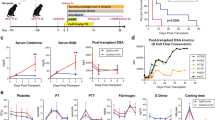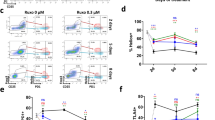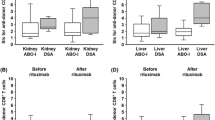Abstract
Cyclosporin A (CS-A) is an unusual endecapeptide isolated from the fungi Cylindrocarpon lucidum Booth and Tri choderma polysporum1. It is a potent immunosuppressive drug that prevents rejection of kidney2–4 and heart5,6 allografts whilst having a low my elotoxicity7. Its mode of action is still unclear but its main target appears to be the T lymphocyte8. The mixed lymphocyte reaction (MLR) and cell-mediated lymphocytoxicity (CML) used here are generally regarded as in vitro correlates of allograft rejection9. Our data show that CS-A is a powerful inhibitor of MLR reactivity, regardless of whether the cells were obtained from normal or presensitized donors; that the CML of lymph node cells is likewise totally inhibited if the drug is added early during cell culture; and that, by contrast, the cytotoxic response of spleen cells from presensitized but not from normal mice is only partially inhibited, even with a tenfold increase in dose. It is therefore suggested that there exists a population of cytotoxic spleen cells that is relatively resistant to the action of this drug.
This is a preview of subscription content, access via your institution
Access options
Subscribe to this journal
Receive 51 print issues and online access
$199.00 per year
only $3.90 per issue
Buy this article
- Purchase on Springer Link
- Instant access to full article PDF
Prices may be subject to local taxes which are calculated during checkout
Similar content being viewed by others
References
Dreyfuss, M. et al. Eur. J. appl. Microbiol. 3, 125–133 (1976).
Calne, R. Y. & White, D. J. G. IRCS J. med. Sci. 5, 595 (1977).
Greene, C. J. & Allison, A. G. Lancet i, 1182–1183 (1978).
Calne, R. Y. et al. Lancet iiI, 1323–1327 (1978).
Calne, R. Y. et al. Lancet i, 1183–1185 (1978).
Jamieson, S. W. et al. Lancet i, 545 (1979).
Borel, J. F., Feurer, C., Gubler, H. U. & Stahelin, H. Agents Actions 6, 468–475 (1976).
Brent, L. Transplantn Proc. 12, 234–243 (1980).
Häyry, P., Andersson, L. C., Nordling, S. & Virolainen, H. Transplantn. Rev. 12, 91–140 (1972).
Cooley, M. A. Scand. J. Immun. 7, 371–380 (1978).
Kuperman, O. J. & Bach, F. J. Scand. J. Immun. 6, 161–172 (1977).
Simpson, E., O'Hopp, S. & Wunderlich, J. Transplantation 18, 374–377 (1974).
Leoni, P., Garcia, R. C. & Allison, A. C. J. clin. Lab. Immun. 1, 67–72 (1978).
White, D. J. G., Plumb, A. M., Pawelec, G. & Brons, G. Transplantation 27, 55–58 (1979).
Author information
Authors and Affiliations
Rights and permissions
About this article
Cite this article
Horsburgh, T., Wood, P. & Brent, L. Suppression of in vitro lymphocyte reactivity by cyclosporin A: existence of a population of drug-resistant cytotoxic lymphocytes. Nature 286, 609–611 (1980). https://doi.org/10.1038/286609a0
Received:
Accepted:
Issue Date:
DOI: https://doi.org/10.1038/286609a0
This article is cited by
-
A new ascochlorin derivative from Cylindrocarpon sp. FKI-4602
The Journal of Antibiotics (2013)
-
Cyclosporine: Immunology, toxicity and pharmacology in experimental animals
Agents and Actions (1984)
-
Cyclosporin A blocks receptors for HLA-DR antigens on T cells
Nature (1981)
Comments
By submitting a comment you agree to abide by our Terms and Community Guidelines. If you find something abusive or that does not comply with our terms or guidelines please flag it as inappropriate.



